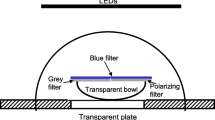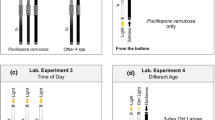Summary
-
1.
The dorsal light reaction has been observed in Daphnia magna Straus with infra-red macrophotography. The body axis (antero-posterior axis) of the Daphnia assumes orientations of 0° to ±40° (median values) from the direction of a light source rather the 90° reported for other arthropods.
-
2.
When Daphnia magna are exposed to a water current moving perpendicularly to the light axis, the body axis orientations are biased toward the current direction. At a current velocity of 0.6 cm/s, half of the median orientations do not differ significantly from a sector of the dorsal light reaction orientations facing the current. The remaining median orientations do differ significantly (p<0.05) and tend to conform more to the direction of the current. At a current velocity of 1.3 cm/s the, body axis orientations tend to conform even more to the direction of current flow (Fig. 6).
-
3.
Biasing of the angular orientations toward the direction of the water current does not happen in total darkness nor at light intensities below 70 erg/cm2/s (the reported threshold for the dorsal light reaction in Daphnia magna).
-
4.
The above facts yield the conclusion that the dorsal light reaction is responsible for the ability of Daphnia magna to orientate into water currents.
Similar content being viewed by others
References
Alverdes, F.: Stato-, Photo- und Tangoreaktionen bei zwei Garneelenarten. Z. vergl. Physiol. 4, 699–765 (1926).
Batschelet, E.: Statistical methods for the analysis of problems in animal orientation and certain biological rhythms. Washington, D. C.: American Institute of Biological Sciences 1965.
Buddenbrock, W. von: Über die Orientierung der Krebse im Raum. Zool. Jb., Abt. allg. Zool. u. Physiol. 34, 479–514 (1914).
Eckert, F.: Die positiv phototaktische Einstellreaktion des Komplexauges von Daphnia pulex im Zweilichterversuch. Lotos 83, 40–70 (1935).
Ewald, W. F.: Über Orientierung, Lokomotion und Lichtreaktionen einiger Cladoceren und deren Bedeutung für die Theorie der Tropismen. Biol. Zbl. 30, 1–16, 49–63, 379–384, 385–399 (1910).
Fraenkel, G., Gunn, D. L.: The orientation of animals. New York: Dover 1961.
Frisch, K. von, Kupelwieser, H.: Über den Einfluß der Lichtfarbe auf die phototaktischen Reaktionen niederer Krebse. Biol. Zbl. 33, 517–552 (1913).
Goodman, L. J.: The role of certain optomotor reactions in regulating stability in the rolling plane during flight in the desert locust, Schistocerca gregaria. J. exp. Biol. 42, 385–407 (1965).
Hess, C.: Neue Untersuchungen über den Lichtsinn bei wirbellosen Tieren. Pflügers Arch. ges. Physiol. 136, 282–367 (1910).
Hutchinson, G. E.: A treatise on limnology, vol. I. New York: John Wiley & Sons 1957.
Jander, R.: Spontaneous changes in the angular orientation of animals. Abstract. Anat. Rec. 134, 587 (1959).
—: Die Phylogenie von Orientierungsmechanismen der Arthropoden. Verh. dtsch. zool. Ges. Jena 29, 266–306 (1966).
Langmuir, I.: Surface motion of water induced by wind. Science 87 (2250), 119–123 (1938).
Mittelstaedt, H.: Physiologie des Gleichgewichtssinnes bei fliegenden Libellen. Z. vergl. Physiol. 32, 422–463 (1950).
Owen, D. B.: Handbook of statistical tables. Reading, Mass.: Addison-Wesley 1960.
Radl, E.: Über den Phototropismus einiger Arthropoden. Biol. Zbl. 21, 75–86 (1901).
Ringelberg, J.: The positively phototactic reaction of Daphnia magna Straus: A contribution to the understanding of diurnal vertical migration. Neth. J. Sea Res. 2, 319–406 (1964).
—, Kasteel, J. van, Servaas, H.: The sensitivity of Daphnia magna Straus to changes in light intensity at various adaptation levels and its implication in diurnal vertical migration. Z. vergl. Physiol. 56, 397–407 (1967).
Schöne, H.: Complex behavior. In: The physiology of crustacea, vol. II (T. H. Waterman, ed.). New York and London: Academic Press 1961.
Umminger, B. L.: Polarotaxis in copepods. I. An endogenous rhythm in polarotaxis in Cyclops vernalis and its relation to vertical migration. Biol. Bull. 135, 239–251 (1968).
Waterman, T. H.: Polarotaxis and primary photoreceptor events in Crustacea. In: The functional organisation of the compound eye (C. G. Bernhard, ed.). Long Island City, New York: Pergamon Press 1966.
Woltereck, R.: Über Funktion, Herkunft und Entstehungsursachen der sog. „Schwebefortsätze“ pelagischer Cladoceren. Zoologica (Stuttg.) 26, 475–550 (1913).
Author information
Authors and Affiliations
Additional information
Submitted as part of a thesis for the degree of Doctor of Philosophy at Yale University.
Professors G. Evelyn Hutchinson, John L. Brooks, and Hilary L. Seal of my thesis committee gave me valuable advice and criticism. Professor Talbot H. Waterman provided both encouragement and equipment for this study. Visiting Professor Peter Moller of Hunter College criticized the manuscript and engaged in many fruitful discussions of the work. Financial assistance was provided by the Honor Society of Phi Kappa Phi, Yale University, Sigma Xi, and a National Science Foundation Training Grant administered by G. Evelyn Hutchinson.
Rights and permissions
About this article
Cite this article
Stavn, R.H. The application of the dorsal light reaction for orientation in water currents by Daphnia magna Straus. Z. Vergl. Physiol. 70, 349–362 (1970). https://doi.org/10.1007/BF00298190
Received:
Issue Date:
DOI: https://doi.org/10.1007/BF00298190




